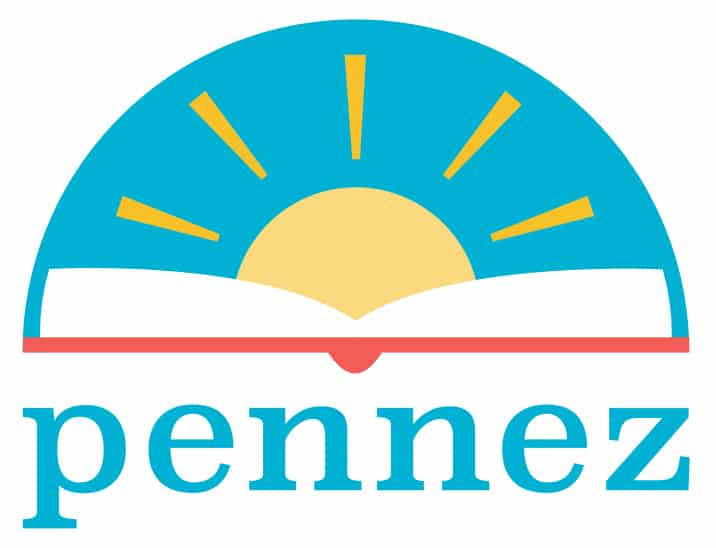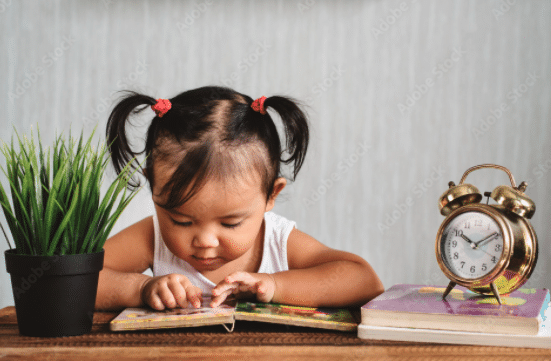
by Rebecca | Jul 16, 2021 | Early Childhood
-
Wanting to teach your baby to read?
-
Looking for ways for early childhood reading?
Introducing reading to your baby or toddler is a fun and challenging endeavor. When it was time to introduce my son to reading, I started before he was 6 months old to help him get in the habit of touching, seeing, feeling, and hearing the words from a book. You might hear from your pediatrician to begin introducing books to your child early on. You can learn more about different stages of reading from this article here.
You might be feeling unsure of when to implement time for reading. One way is to think about times when your child is being involved with routines: Eating food, potty time, bottle time, rest time, or walking time. You might use routines to teach your baby to read. Here are different ways to establish toddler routines.

Eating Food
When it is time to eat food, consider having a book near the table or countertop. Ask questions about the images. Read the story and mimic expressions. If you do not have time to grab a book, then consider reading food box labels and explaining the ingredients, spelling the words, and even discussing the interesting colors and shapes on the box.
Potty Time
Potty training is a time where your child decides when he or she is ready. One way to encourage more time on the potty is by having books nearby. You cannot determine the length of their time, but having a book in that routine can be a consistent pattern your child expects. If it is easier, consider reading flashcards. They are quick, smaller, and could be another way to hold their attention.
Bottle Time
Bottle feeding can be a precious time to tell stories or read a book. During bottle time, your child is more likely still and laying back. This is a perfect time to read a book and you might discover if you are consistent that your child will want a book reading during bottle time.
Walking Time
If you take your child on walks, bus rides, or even car rides, you can use that time to describe what you see outside. You can start by naming things, describing them, giving examples of them, and then possibly sharing a story about what you see. Walking or mobile times can be used to expand your child’s vocabulary and learn the language about their environment.
Wake up/Nap Time
Laughter at 7 AM might be beaming through your door. Where your toddler breaks your moment of sleep. We know that bedtime stories are great ways to relax your child for sleeping. Consider other sleep times where you can read when she first wakes up. You can read before placing her down for her nap.
Reading during routines can give you and your child different opportunities to read. Additional information on Introducing Early Reading .
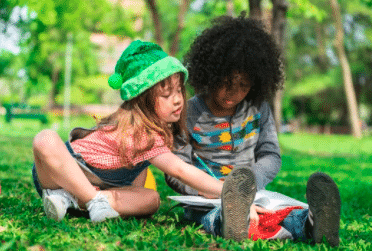
by Rebecca | Jul 14, 2021 | Booklists, Parents
-
Books about Earth & Climate Change Books for Kids
-
Nature Books for Children
Enjoy these picture books about nature that your child might love to read. These books range from riddles, fiction nature books, and non-fiction books. With broader topics about healing the earth and climate change, these books can bring conversations about protecting our Earth.
A New Green Day by Antoinette Portis
Nature is described in this book of riddles. Discover the voice of a snail, the sunlight, my, lightning, and so many more wonder that our world has. I’m a chorus of a million tiny voices. Come splash in my song, says rain. You will have fun guessing the riddle as you read this colorful book.
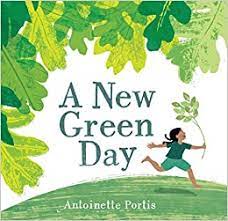
The Very Last Leaf by Stef Wade
A leaf learns that he spins the summer learning about his life period of then when fall comes he learns that he must fall to the ground just like his answer. Even though this small leaf is a great student and loves who he is he is terrified to fall. We learn what it means and why leaves must fall each year through the eyes of a leaf.
Honeybee by Candace Fleming
The Busy Life of Apis Mellifera
Learn how the honeybee grows from larva, to worker bee, and then passing on. The illustrator takes us inside the beehive where the queen lays 2,000 eggs per day. We follow the life of one bee named scientifically Apis. Once Apis emerges from her cell we learn how busy her life is-tending eggs, cleaning, caring for the queen, building the hive, and even protecting this. She must do all this work well before she searches for flower nectar.
Heal the Earth by Julian Lennon
Children are on an adventure exploring every continent. They learn how to protect the ocean. They learn about rainforests. They also learn how to make cities greener. With these children learn how caring for them is a fun.
Rubies Birds by Mya Thompson
Ruby is a happy little girl. She spends her time doing great things. But she loves visiting Central Park to watch all of the unique birds. She also joyously takes her family to the park to see another bird that she loves to hear.
Over and Under the Rain Forest by Kate Messner
Walk into the rain forest with a little girl and her Uncle as they view the wonders of a hidden. Sometimes, a lizard scrambles across the water. Other times, new songs filled the air as nighttime falls.
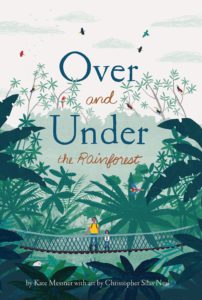
Over and Under the Pond by Kate Messner
Discover the world of life in a pond. Herbivores take their time to find Decadent plants to eat. Carnivores stealthily wait in till they find the best animal to grab and eat. In the story, a little boy and his mother Canoe in the pine sing all the wonderful life that exists in this ecosystem.
Rocket Cleans Up! By Nathan Bryon
Rocket is a tenacious little girl who will do anything to solve a problem. When she visits the beach at her grandparent’s house she discovers a lot of trash lying around and endangering the animals. Luckily, Rocket does what any young child would do and clean up the beach.
The Tree in Me by Corina Luyken
A story for young readers that shows how nature is a part of all this. The Tree and Me demonstrate how the Sun shines through And Us. How the tree protects us. How we can use fruits and nuts to nourish our bodies.

We Are Water Protectors
By Carole Lindstrom
Native people discuss the dangers of hurting our water system, how they have protected it, and what to do to make a change.
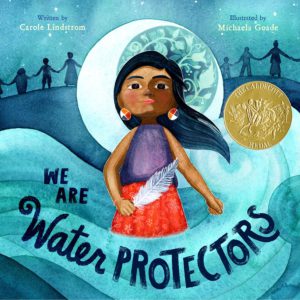
Climate Change and How We’ll Fix It by Alice Harman
This book is for children ages 7 and up. Explains the problems of climate change with graphics and powerful messages.
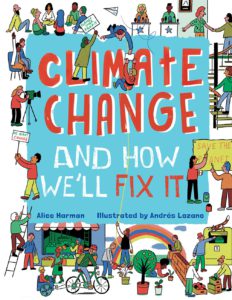
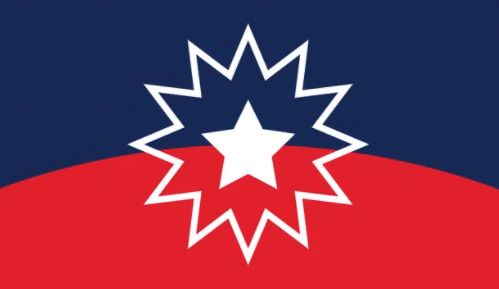
by Rebecca | Jun 20, 2021 | Educators, Parents, Reading Strategies
-
Topics about Juneteenth
-
Vocabulary words and questions about Juneteenth
Successful Black Parenting Magazine provides 19 suggestions on Real Learning Activities for Families About Juneteenth. “These activities are suggestions. Take them and customize them for the age of your child. Young children, under the age of six, should not learn any details about slavery but instead celebrate the freedom aspect of Juneteenth. From ages seven-to-nine, gory details should be left out. Children over ages 10-13 may be able to handle more graphic aspects. You can guide your children to create book reports, diagrams, dioramas, poster art, a tri-board presentation, or a PowerPoint presentation of the following activities. Encourage them not to just copy and paste but to read everything and to use their own words and thoughts about the subject they choose.”
Just because Juneteenth has ended, you can continue to find ways as the editor suggested above to keep the truth alive. Below are additional Juneteenth reading activities for children and vocabulary terms. If you are searching for books, you can find a Booklist here.
1. Amendments (13th, 14th, 15th )
What are the amendments?
What do laws do?
Who makes these laws?
Give examples on how the amendments affects your life now.
2. The First African American Senators (First Colored Senators)
Who were they?
Why do you think they were primarily from the South?
Why were their roles significant?
How did Reconstruction affect their roles?
3. What is Reconstruction?
What were the periods of peace and hope?
How did African Americans survive during this time period?
How long was Reconstruction?
Visual Reading Guide Here
4. Voting
What was the significance of voting during these times?
- The 15th Amendment of 1869 giving citizens voting rights
- Voting Rights Act of 1965
- Voting Restrictions of 2021
5. Discover Narratives of People Who Faced Slavery and what they did to live as a Citizen
Read Jourdon Anderson’s Letter to his Former Master
Jourdon’s Master asked that he come back to work on the plantation. Jourdon’s response was powerful and even included mathematical equations for the money that he was owed from his years of enslavement.
Juneteenth has a rich history of customs and celebrations to remember people affected from slavery. Below are additional vocabulary words.
Vocabulary Words
Propaganda
African descent
African diaspora
Blackface
American Colonization Society
Stereotype
Scientific racism
Classism
Confederacy
Union

by Rebecca | Jun 13, 2021 | Booklists, Educators, Parents
-
Booklist: Books about the Juneteenth holiday and what it means for African American communities.
-
Juneteenth is a holiday to celebrate the end of enslavement. After enslavement was Reconstruction. After and during Reconstruction the Black Codes were established. A short history from Stony the Road.
Juneteenth is celebrated on June 19th each year in African American communities to celebrate when the Union army announced the freedom of slaves in 1865 in Galveston, Texas. However, two years before this announcement, Abraham Lincoln issued the Emancipation Proclamation in 1863 during the Civil War. This Proclamation gave slaves the freedom of enslavement. Still, other challenges arose from slaves becoming free. For example, the ideologies of white supremacy remained where Black Codes and then the Jim Crow Laws were established.
After the Civil War ended, Reconstruction took place to bring the Confederate states back into the Union while also giving African Americans freedom, citizenship, political rights, civil rights, and economic rights. In many ways, Reconstruction did not give Blacks the rights they expected. Other scholars say that it failed. 1
Despite the challenges from former slaveholders and society, African Americans continue to celebrate how far they have come and Juneteenth is one example. Below are Juneteenth books for children in grades Pre-K through 5th.
1. Juneteenth by RJ Bailey
A story for pre-K through kindergarten readers. Describes what this holiday means and what people do such as parades food and gatherings.
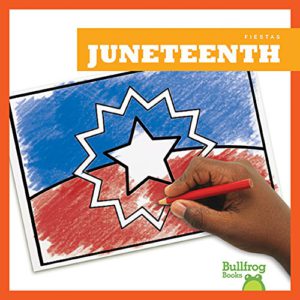
2. Juneteenth by Vaunda Micheaux Nelson and Drew Wilson
A detailed story for K-2 readers. This story describes how the last news was shared about the end of slavery in Galveston Texas. Even though the news was shared in 1865, during the Civil War Abraham Lincoln signed the Emancipation Proclamation in 1863. In the end, this
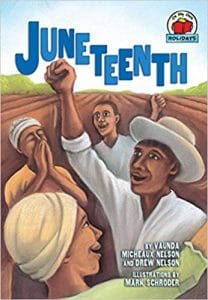
3. Juneteenth for Mazie by Floyd Cooper
Mazie’s father tells her how her grandfather was a former slave and heard the news in Galveston Texas. He then told her how black people struggled after they were freed but kept working for equal rights. He encourages his daughter to celebrate and to remember.

4. Let’s Celebrate Emancipation Day and Juneteenth by Barbara deRubertis
A nonfiction book for elementary readers discussing the reasons why Juneteenth even started which was due to the end of slavery. The author shares facts about pivotal abolitionists-such as Frederick Douglass. Later the author shares what life was like after the proclamation was given. Even though slavery is a dark part of our history Juneteenth celebrates freedom and about our ancestors as this book shares at the end.

5. All Different Now By Angela Johnson Illustrated by EB Lewis
A story about a small enslaved child who witnessed her family becoming free. The illustrations captivate the narrative’s emotions. The writer writes in a poetic form to demonstrate the tremendous hope and joy that oppressed people heard about being free from enslavement.
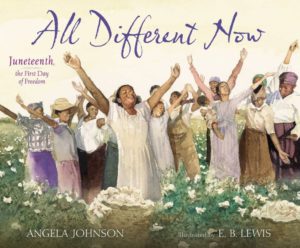
6. Freedom’s Gifts By Valerie Wesley
A Juneteenth Story
June lives in Texas in 1943. African American people living in the South were legally segregated from the white community. This year and June was going to celebrate Juneteenth with her family and her cousin Lillie who lived in the North. June enjoyed where she lived, but Lillie always complained. June didn’t say anything. Through the story, we learn about her Aunt Marshall who witnessed slavery. She didn’t enjoy discussing it but loved Juneteenth. This story brings generational experiences and historical experiences about what it means to be Black and free.
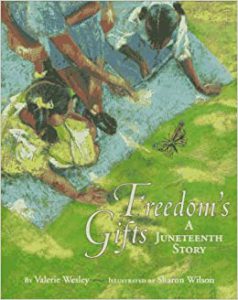
7. Come Juneteenth by Ann Rinaldi
A historical fiction novel for Elementary-aged readers. Luli lives in Texas but is raised by her Master’s family. She enjoys her family and is afraid of change. Once she discovers that slaves are free, she does not tell. Two years later, soldiers come to Texas and her world is changed forever.
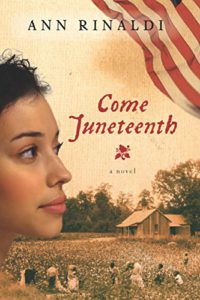
8. The Story of Juneteenth An Interactive History Adventure
By Steven Otfinoski
This reader for elementary-aged readers allows the reader to choose a different story paths and endings. The reader decides to follow the story of a teenage girl, or a black man. Some endings have joy, others endings are faced due to racism. Not only does one learn about Juneteenth, but they learn what happens to African Americans once they are freed from slavery.
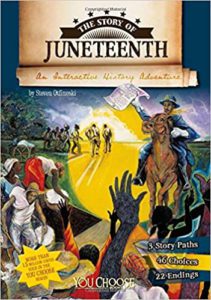
More details from Stony the Road provides dates and explanations on what happened after Black Americans were freed from enslavement.
- 1865-1877 is the Reconstruction era in the United States. Reconstruction ended in 1877, because of the 1877 Compromise. This Compromise gave Confederate Democratic states electoral votes in exchange for a withdraw of federal troops in the South.
- 1865 Mississippi and South Carolina were some of the first states enacting the Black Codes which restricted Black people from specific freedoms. Eventually, former Confederate states adopted the Black Codes.
- Post Civil War, the 13th, 14th, and 15th Amendments were ratified to end slavery, give Black men the right to vote, and recognize an individual’s citizenship if born in the United States.
There was also a larger question in the North and South was what to do with the Negro. The Cincinnati Enquirer stated, “Slavery is dead,” but “The negro is not, there is the misfortune.” We all know this was too true.
Quasi-Slavery or Quasi-Freedom
Former slaves were either migrating to the North to look for better jobs, and some remained working for a wage with their former Plantation owners. Henry Louis Gates calls this period “quasi-freedom or quasi-slavery: a state of being trapped in nether zone, between a state of being and nothingness, painted as unworthy of citizenship rights granted prematurely by contemporaries eager to justify the implementation of neo-slavery.” 1
One area of importance is that the celebration of enslavement ended, the need for cotton increased from 1860-1890, and doubled in 1920. Cotton was considered “King” because it made plantation owners wealthy and grew their capital. Once slavery ended Blacks were converted into sharecroppers.
Sharecropping is defined as a category of farming where owners rented parts of their land to families. Whenever families grew a portion of their crops of part of their crops were given to the landowner. In essence, this became an economic deficit because families owed the landowners money if they were not able to produce the number of funds to cover their crops.
The sentiment of being freed was an event that altered the lives of millions of African Americans. 1 Frederick Douglass spoke, “At last, at last the black man has a future. Heretofore all was dark, mysterious, chaotic. We were chained to all the utterable horrors of never ending fixedness. Others might improve and make progress, but for us, there was nothing but the unending monotony of stagnation, for moral, mental and social death. Today we are free American citizens. We have ourselves, we have a country, and we have a future in common with other men.
More Booklists Here
1 Gates, H. L. (2019). Stony the Road. Penguin Press.
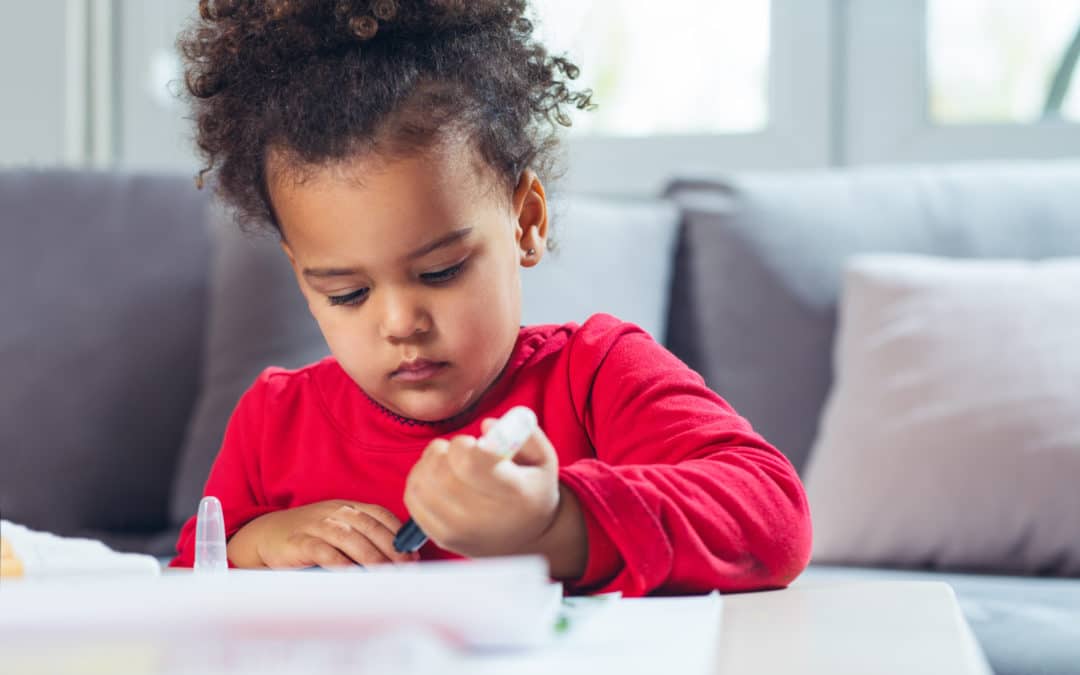
by Rebecca | Jun 4, 2021 | Early Childhood
-
Language and Literacy for the Early Years
-
Early Reading Strategies for Kids
Introducing literacy skills and reading at an early age can provide the abilities to help your child grasp the language and skills to succeed as they grow. It is never too early to start, and you can provide a wonderful environment at your home. Parents can be the initial teachers to open the world for your child. Starting early does not only include reading a book but includes conversations, music, observations, and viewing images. These moments build literacy. Literacy is further explained here.
Ways to Teaching Early Reading
- Conversations-At the ages of 1, 2, 3, and 4 your child is experimenting with words and is speaking different phrases and sentences. With your 2-year-old, you might hear fewer words. Your 3-year-old might be forming clear and even silly sentences. Then by the age of 4-years old an expansion of vocabulary weaved into those sentences should be apparent. When you can, take advantage of any age to build their vocabulary through these fruitful conversations. If you hear singular words such as “truck,” “dog,” or “ball,” then describe what your child says, ask questions about it, or point to examples. When your child becomes older, continue the conversations and add new vocabulary words naturally to help them understand the conversation.
- Repetition– It is important to repeat the words that your children say because it provides more practice opportunities and memory building. When repeating, be intentional on words that might be useful. Be mindful of the language. When repeating, you can use different tones, emotions, and even objects to demonstrate how these words are different depending on the context. You can find more examples here.
- Read Daily-Take the time to read 2-4 books each day. Reading aloud each day gives the introduction to vocabulary words, sentence structure, word sounds, and the usage of language itself. Find ways to point out words and ask questions. Also, when selecting books, select nonfiction, poetry, and fiction text so your child can see the different word patterns. Reading aloud is a fun activity that encourages voice changes, expression, and fluency.

- Flashcards-Flashcards can be used for reading, viewing, listening, and speaking. Flashcards for young readers should have images so you can discuss the story, match similar images or words, identify colors, and see if you can find different categories or relationships with the cards such as animal words, food words, and more. Flashcards are great tools to display information quickly. Sample pack here.
- Screen Time-In the 21st century, logging on to YouTube, or giving your child a tablet to watch seems like a simple solution. If you must have your child watch a video, then repeat what you hear and expand on ideas from the video. Think about reinforcing vocabulary and encouraging your child to answer questions the character says. Technology is not the most important measure, but understand that as parents this might be one of your only options.Parenting is a challenge where sometimes placing your child in front of the television means getting more work completed, finishing up a household chore, or needing to take time for yourself. For whatever reason use screen time with the intent to learn by watching high-quality programming that can improve your child’s vocabulary and cognitive abilities. Also, consider the time limit. This article shares the impact technology can have on our children.
- Toys-The power of play for your child can have positive outcomes to build language, creativity, discovery, and even fine motor skills. With toys you can describe, categorize, and tell stories with. Play gives children the opportunity to try new things and learn from their mistakes. In this article, “Early learning and play are fundamentally social activities and fuel the development of language and thought. Early learning also combines playful discovery with the development of social-emotional skills. It has been demonstrated that children playing with toys act like scientists and learn by looking and listening to those around them.” When you encourage your child to play, you are providing opportunities for language growth and so much more.
- Routines-Decide throughout the day when you want to read a book or practice flashcards. Early language learning is critical. Children enjoy routines and predictability. I encourage you to have bookshelves or containers of books in your home. Books should be accessible when it is time for that time to read. You can establish the routine of reading a book when introducing new routines. For example, eating at the table, potty time, a new nap schedule, relaxing, and even car rides. One effective to motivate your young reader is to get into the habit of reading yourself. When your child sees you read, they might want to model after you.
- Be Intentional-Planning ahead might be a lot for working parents. However, reflect weekly on what it is that you want your child to do. This can be as simple as, “Each day we will read 2 books.” “Each day we will learn one new English and Spanish word.” “Each day I will ask what did you learn at school and tell me how you did it.” There are numerous ways to establish your educational intent with your child. Ultimately this pattern for yourself can help you when your child is school age.
- Writing/Scribbles-A pencil, crayon, marker, or paintbrush should be comfortable and familiar tools for your child. Once my son was holding a spoon for a few months, I introduce each tool little by little. Once he turned two, he identified and used each tool appropriately for use. I encourage my son to scribble, color, or paint every day so he can develop his fine motor skills and control. One suggestion is to have a notebook just for your child, and let them scribble away.
Feel free to contact us for additional information or consulting.
Additional resource here


